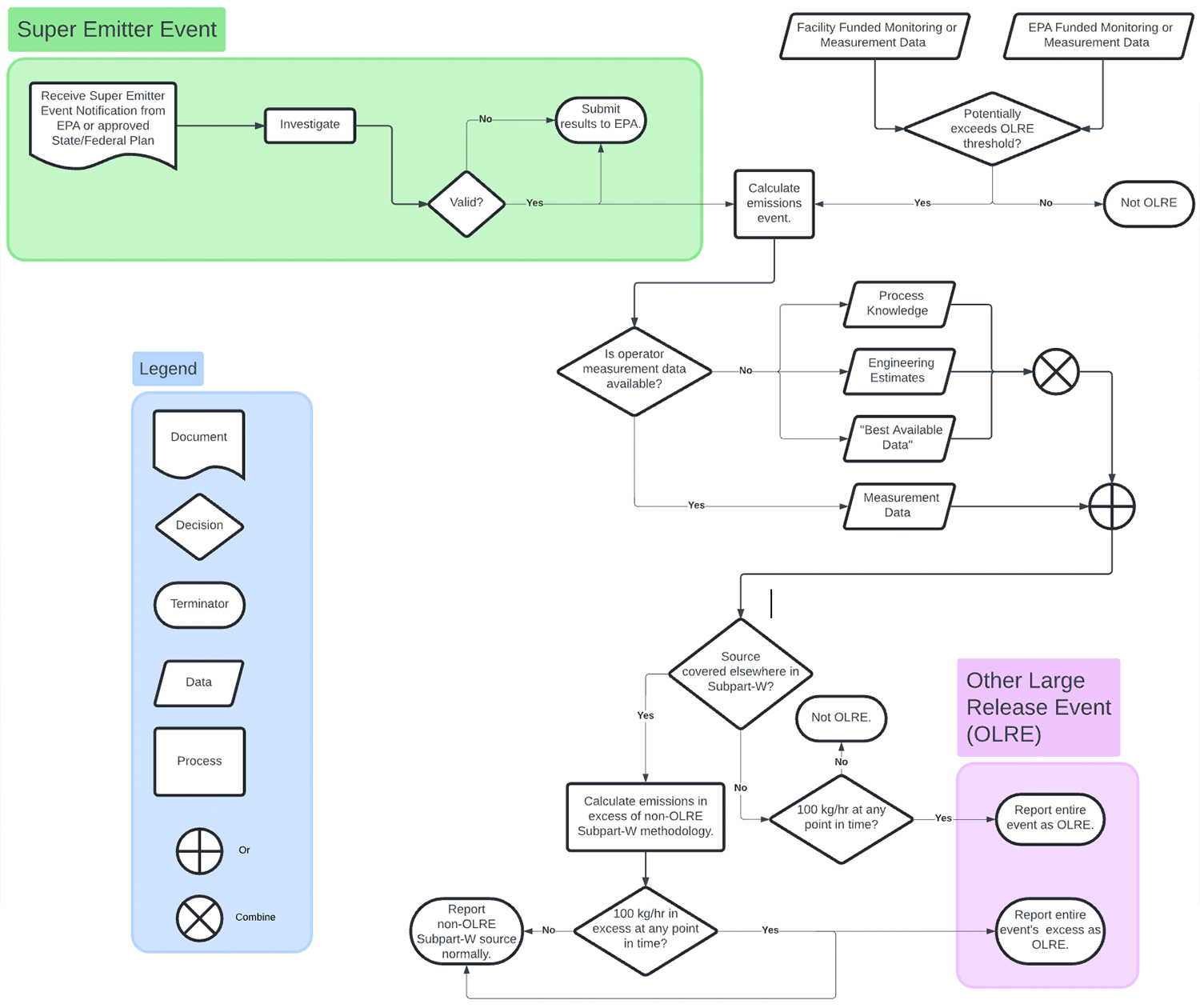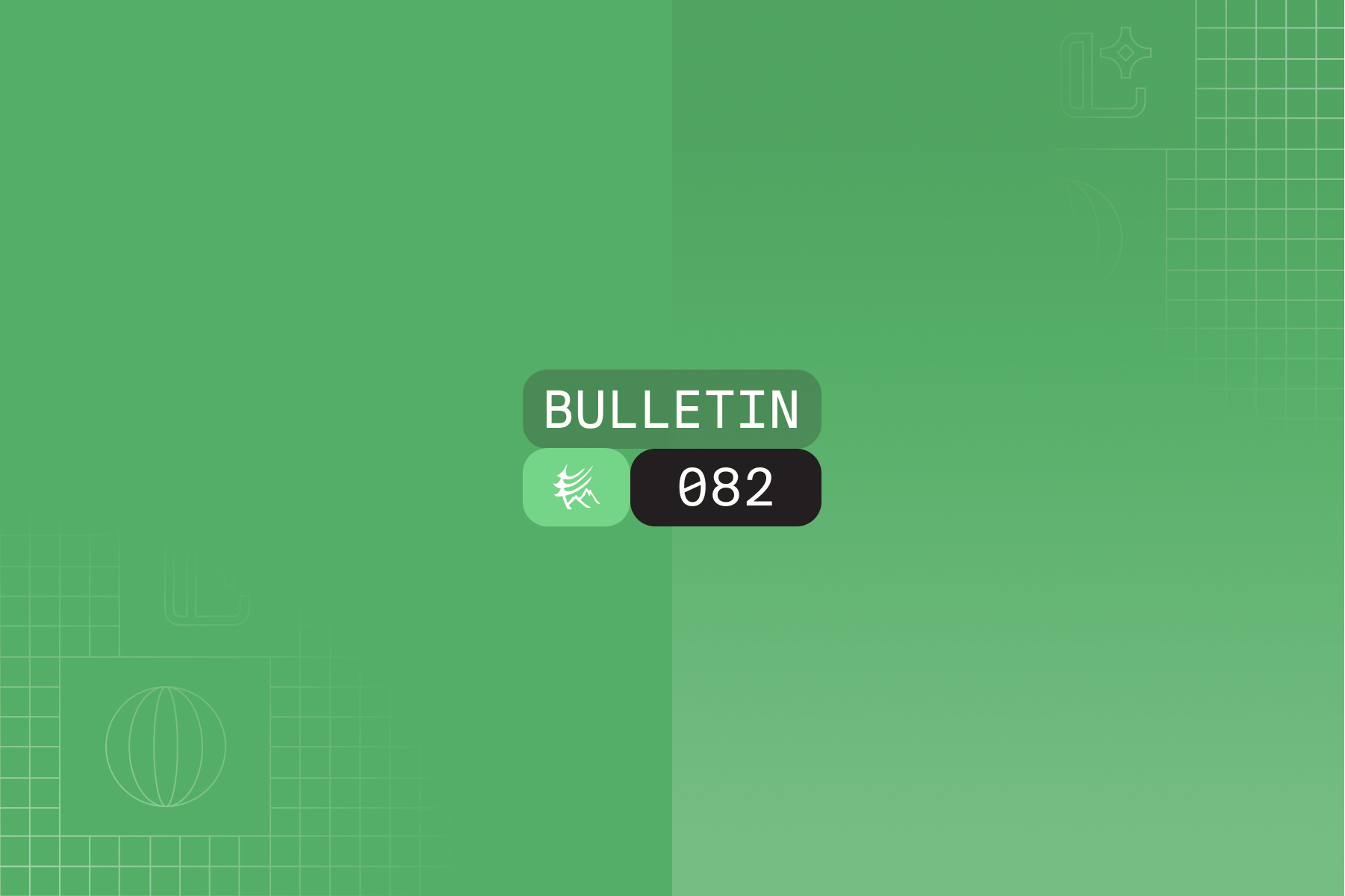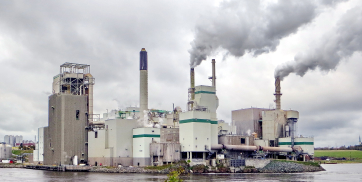What is the Difference Between a Super-Emitter Event and an Other Large Release Event?
In order to meet directives from the Inflation Reduction Act, the EPA has been rapidly updating its methane rules. This includes (but is not limited to):
- The establishment of a Super-Emitter Program, which includes Super Emitter Event Notifications (SEEN, codified in OOOOb1 and OOOOc2).
- Updates to the GHGRP to include more measurements, such as Other Large Release Events (OLRE, codified in Subpart-W).
Although the Super-Emitter regulations in OOOOb and OOOOc are extremely similar, OOOOc’s equivalency deadlines are years away; therefore, we will focus on the presently in force OOOOb. Although OOOOb’s SEEN and Subpart-W’s OLRE are designed in alignment, they are not the same thing. We will explain below the methodology, including a convenient flowchart, where a SEEN can trigger an OLRE. However, A SEEN can exist without becoming an OLRE, and an OLRE can exist without a preceding SEEN.
What is a Super-Emitter Event?
Within OOOOb (§ 60.5371b), a Super-Emitter Event is defined as any oil and gas emissions event, remotely detected, emitting 100 kg/hr of methane or greater.3 In a previous article, we explained how third parties qualified in remote detection can submit detections to the EPA, which will then be verified and forwarded as a Super-Emitter Event Notification (SEEN) to the operator believed to be responsible. The operator must investigate the event and report back to the EPA within 15 days, including the following details:
- Whether a facility is owned within 50 meters of the notified location.4
- Review of, since the date of detection indicated in the SEEN, all maintenance activities, control device monitoring data, fugitive emissions/screening surveys, and continuous monitoring data.
- Screen the entire facility with OGI, method 21, or approved alternative test method.
- Identification of the source, and when the event will end or has ended.
- Whether the source is subject to Subpart OOOOb.1,5
Additionally, if the investigation reveals the Super-Emitter Event to be from a fugitive emissions at a well site, centralized production facility, or compressor station subject to OOOOb, the operator must then repair as prescribed in § 60.5397b.
What is an Other Large Release Event?
Any source that is known by the operator to emit, at any snapshot in time, 100 kg/h more than what is reported with Subpart-W methodology, is an Other Large Release Event (OLRE). If an operator receives a SEEN, or becomes aware through “EPA or facility-funded monitoring or measurement data” that the 100 kg/h threshold may have been exceeded, the operator must calculate the emissions event. If available, the operator is required to use internal measurement data as specified in § 98.234(b). When measurement data is not available, the operator must use “a combination of process knowledge, engineering estimates, and best available data”. In the absence of other data, the SEEN’s snapshot emissions rate could be the best available data.
If the source isn’t covered elsewhere in Subpart-W,6 then the threshold is simply 100 kg/h. If the source does exist elsewhere in Subpart-W (excepting vent stack blowdowns), then the threshold is if the known emissions are at least 100 kg/h greater than what is being reported through that source’s non-OLRE Subpart-W methodology.6 The OLRE excess emissions and non-OLRE source emissions are then required to be reported separately for those sources. If the event results from several sources with one common root cause, then all sources must be summed to determine whether the threshold was exceeded. Further, the EPA specifies that the entire event must be reported, not just the portion that exceeds the 100 kg/h threshold.
How are SEENs and OLREs related?
If you receive a SEEN from the EPA, the event is determined to be valid, and at least 100 kg/h (at any snapshot in time) of that is not already covered in other parts of Subpart-W methodology, you have to report it as an OLRE. However, if you receive a SEEN that is already reported up to the OLRE threshold, or not valid for another reason (eg, demonstrable error), then the Super-Emitter Event it is not subject to OLRE reporting. In all cases, the operator must respond to the EPA with a Super-Emitter Event Report.
You may also become aware of sources potentially exceeding the OLRE threshold without receiving a SEEN from the EPA (eg, internal surveys). In this case, you are required to calculate the event and report as an OLRE if all the criteria are met. However, any OLRE found this way is not subject to a Super-Emitter Event Report, and unless it was detected using remote methods, would not fall under the EPA’s definition of a Super-Emitter Event.
What is the incentive to gather data internally and possibly be exposed to additional OLREs beyond those triggered by EPA provided SEENs? In the absence of any other information, the operator is required to assume the Super-Emitter Event occurred for 91 days prior to the third party’s detection at the third party’s detected snapshot rate. If the true average emission rate was lower than the SEEN provided snapshot rate, the operator would be assessed a higher Waste Emissions Charge (see previous article here) than what could have instead been owed with internal measurement data.
Highwood Can Help
EPA’s labyrinth of Waste Emissions Charges, Subpart-W, and the Super-Emitter Program have the potential to be highly disruptive to the oil and gas industry. However, Highwood specializes in helping clients understand and reduce their emissions to stay ahead of regulations. Through our experience in planning and executing emissions reduction initiatives, our clients achieve unparalleled standards in methane emissions. We’ve leveraged our unmatched expertise in measurement-informed inventories to develop industry leading software, raising the bar for defensibility in emissions reduction quantification.
Contact us to set up a brief chat and learn more.

1 Subpart OOOOb—Standards of Performance for Crude Oil and Natural Gas Facilities for Which Construction, Modification or Reconstruction Commenced After December 6, 2022.
2 Subpart OOOOc—Emissions Guidelines for Greenhouse Gas Emissions From Existing Crude Oil and Natural Gas Facilities that commenced construction, modification, or reconstruction on or before December 6, 2022.
3 “any emissions event that is located at or near an oil and natural gas facility (e.g., individual well site, centralized production facility, natural gas processing plant, or compressor station) and that is detected using remote detection methods and has quantified emission rate of 100 kg/hr of methane or greater.”
4 ”If you do not own or operate an oil and natural gas facility within 50 meters from the latitude and longitude provided in the notification, report this result to the EPA under paragraph (e) of this section. Your super-emitter event investigation is deemed complete.”
5 Wells, centrifugal & reciprocating compressors, process controllers, storage vessels, process unit equipment, sweetening units, pumps, and fugitive emissions components at well sites, centralized production facilities, or compressor stations. Local Distribution Company (LDC) custody transfer stations are excepted.
6 Pneumatic device & pump venting, AGR vents, Dehydrator vents, Well venting for liquids unloadings, Venting during completions and workovers, Blowdown vent stacks, Onshore storage tanks (production, gathering, boosting, & transmission), Well testing/ associated gas venting & flaring, Flare stack emissions, Compressor venting, Equipment leaks, Offshore production facilities, EOR injection pump blowdown & hydrocarbon liquids dissolved CO2, Drilling mud degassing, and Crankcase venting.





